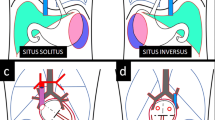Abstract
Heterotaxy is a rare congenital disorder characterised by abnormal viscero-vascular situs with either left or right isomerism that usually coincides with complex cardiac malformation. A precise diagnosis must be made for the selection of the most appropriate treatment. The diagnosis and evaluation of these conditions have been dependent on invasive studies such as angiocardiography, although more recently magnetic resonance imaging (MRI) has been advocated. In paediatric patients MRI is far from ideal because of the need for sedation and monitoring during the examination. The authors reviewed the modalities used in the evaluation of heterotaxy with emphasis on the use of ultrasonography, including pulse and colour flow Doppler imaging. A series of 14 children with heterotaxy is presented; ten with left abdominal isomerism (polysplenia) and four with right isomerism (asplenia). Results of abdominal sonography were compared with those of echo- and angiocardiography, surgery and autopsy. Of the ten children with left abdominal isomerism, two had no cardiac abnormalities. All those with right isomerism had a complex vitium. One patient with left abdominal isomerism proved to have right atrial isomerism. Some new reproducible patterns in viscero-vascular derangement are reported. The predictable patterns of left and right isomerism are outlined and atypical features discussed.
Similar content being viewed by others
References
Hastreiter AR, Rodriguez-Coronal A (1968) Discordant situs of thoracic and abdominal viscera. Am J Cardiol 22:111–118
Freedom RM (1971) The heterotaxy syndrome (abstract). Circulation [Suppl 2] 44: 420
Caruso G, Becker AE (1979) How to determine atrial situs? Consideration initiated by three cases of absent spleen with a discordant anatomy between bronchi and atria. Br Heart J 41: 559–567
Hernanz-Schulman M, Ambrosino MM, Genieser NB, Friedman D, Banner H, et al (1990) Current evaluation of the patient with abnormal visceroatrial situs. AJR 154: 797–802
Deanfield JE, Leanage R, Stroobant J, Chrispin AR, Taylor JFN, et al (1980) Use of high kilovoltage filtered beam radiograph for detection of bronchial situs in infants and young children. Br Heart J 44: 577–583
Huhta JC, Smallhorn JF, MacCartney FJ (1982) Two dimensional echocardiographic diagnosis of situs. Br Heart J 48: 97–108
Guit GL, Bluemm R, Rohmer J, Wenink AC, Chin JC, et al (1986) Levotransposition of the aorta: identification of segmental cardiac anatomy using MR imaging. Radiology 161: 673–679
Rose V, Izukawa T, Moes CAF (1975) Syndromes of asplenia and polysplenia - a review of cardiac and noncardiac malformations in 60 cases with special reference to diagnosis and prognosis. Br Heart J 37: 840–852
Abramson SJ, Berdon WE, Altman RP, Amodio JB, Levy J (1987) Biliary atresia and noncardiac polysplenia syndrome: US and surgical considerations. Radiology 163: 377–379
Van Praagh R, Van Praagh S (1990) Atrial isomerism in the het-erotaxy syndromes with asplenia, or polysplenia, or normally formed spleen: an erroneous concept. Am J Cardiol 66: 1504–1506
Higgins CB, Silverman NH, Kersting-Sommerhoff B, Schmidt KG (1990) Congenital heart disease: echocardiography and magnetic resonance imaging. Raven, New York, pp 73–88
Stewart DE, Steigman CK, Mahoney KJ, Signs MM, Cobb LM (1992) Obstructive jaundice associated with polysplenia syndrome in an older child. J Pediatr Surg 27:1575–1577
Heller RM, Dorst JP, James AE, Rowe RD (1971) A useful sign in the recognition of azygos continuation of the inferior vena cava. Radiology 101: 519–522
Sapire DW, Ho SY, Anderson RH, Rigby ML (1986) Diagnosis and significance of atrial isomerism. Am J Cardiol 58: 342–346
Author information
Authors and Affiliations
Rights and permissions
About this article
Cite this article
Oleszczuk-Raschke, K., Set, P.A.K., von Lengerke, H.J. et al. Abdominal sonography in the evaluation of heterotaxy in children. Pediatr Radiol 25 (Suppl 1), S150–S156 (1995). https://doi.org/10.1007/BF03545614
Received:
Accepted:
Published:
Issue Date:
DOI: https://doi.org/10.1007/BF03545614




